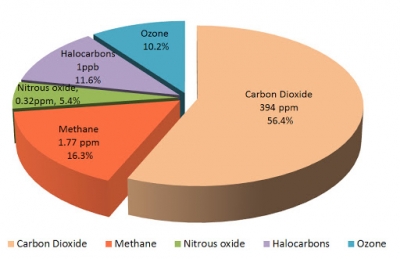
Methane (CH4) is the second most important greenhouse gas. It is more potent than CO2, but exists in far lower concentrations in the atmosphere. CH4 also hangs around in the atmosphere for a shorter time than CO2—the residence time for CH4 is roughly 10 years, compared with hundreds of years for CO2. Natural sources of methane include many wetlands, methane-oxidizing bacteria that feed on organic material consumed by termites, volcanoes, seepage vents of the seafloor in regions rich with organic sediment, and methane hydrates trapped along the continental shelves of the oceans and in polar permafrost. The primary natural sink for methane is the atmosphere itself; another natural sink is soil, where methane is oxidized by bacteria.
As with CO2, human activity is increasing the CH4 concentration faster than it can be offset by natural sinks. Human sources (rice cultivation, livestock farming, the burning of coal and natural gas, biomass combustion, and decomposition in landfills) currently account for approximately 70 percent of total annual emissions, leading to substantial increases in concentration over time.
Picture Credit : Google




